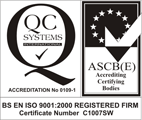Lower Billacott Farm, North Petherwin, Launceston PL15 8LT
Tel: +44 (0) 845 3700 266 Fax: +44 (0) 845 3700 277
Precision Balls
Hastelloy C-276 and 'D' Balls

| General Information: | |||
| Hastelloy is used extensively in check valves where maximum resistance to corrosion and wear is required. | |||
| Basic Composition: | Hastelloy C-276 | Hastelloy 'D' | |
| Chromium | 14.5/16.5% | 1% Max. | |
| Carbon | 0.02% Max. | 0.12% Max. | |
| Molybdenum | 15/17% | --- | |
| Silicon | 0.08% | 7.5/10% | |
| Manganese | 1.0% Max. | 0.50/1.25% | |
| Iron | 4/7% | 2.0% Max. | |
| Nickel | Balance | Balance | |
| Tungsten | 3.0/4.5% | --- | |
| Cobalt | 2.5% Max. | 1.5% Max. | |
| Copper | --- | 2/4% | |
| Mechanical Properties: | |||
| Hardness | 87-90 Rockwell 'B' | 30-39 Rockwell 'C' | |
| Density | 0.321lbs/cub.in. | 0.282lbs/cub.in. | |
| Specific Gravity | 8.88 | 7.81 | |
| Size Range: | Hastelloy C-276 | Hastelloy 'D' | |
| Imperial | 1/8" to 1.7/8" incl. | 1/4" to 1" incl. | |
| Tolerances: | |||
| Basic Dia.Tolerance | ±.002" | ||
| Sphericity | .0001" | ||
| Surface Finish (RMS) | 5 micro-inch | ||
| Corrosion Resistance: | |||
| Hastelloy C-276 is noted for its exceptional resistance to attack by strong oxidizing agents including cupric and ferric chlorides, chlorine, formic and acetic acids, acetic anhydride and brine solutions. It also resists the corrosive effects of hypochlorite, chlorine dioxide solutions and wet chlorine gas. Hastelloy 'D' is best known for its resistance to sulphuric acid at all concentrations and temperatures- even at boiling point, and also resists other corrosives including organic acids and acid salts. | |||
